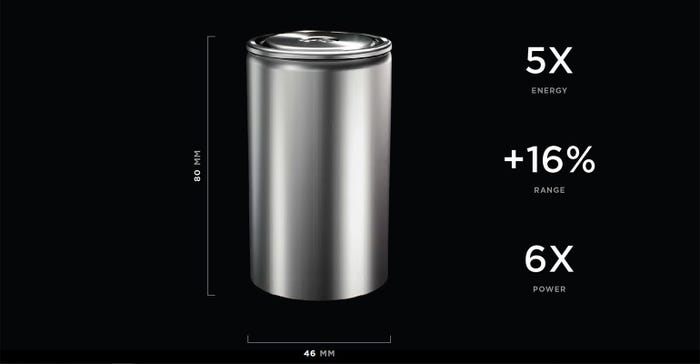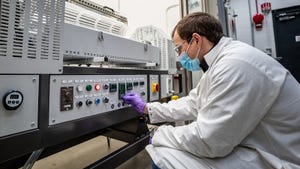Tesla Accelerates Plans for Entry-Level EVs, Robotaxis & IA-Powered Robots
Q1 earnings call ties 4680 cell production to Cybertruck; underlines CEO Musk’s vision of Tesla as 'not a car company.'

At a Glance
- Tesla, thought to be reeling from poor sales and plummeting stock share value, held its Q1 earning call with investors.
- The call confirmed lower profits but promised developments in autonomous driving, AI-powered robots, & cheaper EV models.
- The call also detailed 4680 cell status.
The EV and battery industries may be getting vertigo from following Tesla this month:
On April 2, Tesla reported that in the first quarter of this year it built 433,000 vehicles—but delivered only 387,000 of them. The next day, the company’s stock was the worst performer in the benchmark S&P 500.
Last week, Tesla announced the recall of almost 4,000 Cybertrucks due to an accelerator pedal problem, laid off 10% of its workforce and lost two of its key executives.
And in its earnings call with investors this week, Tesla confirmed its first-quarter revenues dropped 9%, its steepest year-over-year decline since 2012.
But the day after the earnings call, investors were reportedly sighing with relief and Tesla shares surged 12%, according to CNBC and the business press.
So, what happened?
So, what happened? The company made production of fully autonomous cars, robotaxis, and factory-ready AI-driven robots sound tantalizingly close: The company’s humanoid-looking Optimus robot is already doing basic tasks at Tesla factories and could go on sale by 2025, the company reported. But that probably wouldn’t have been enough by itself to elicit the stock-market vote of confidence afterward.

Tesla CEO Elon Musk at the New York Times annual DealBook summit on November 29, 2023 in New York City. CREDIT: MICHAEL M. SANTIAGO / GETTY IMAGES NEWS VIA GETTY IMAGES
Good news about the company's energy generation & storage business revenue and gross profits might have helped: These achieved an all-time high in the first quarter, with year-over-year revenues up 7% and gross profit up 140%, driven by increased Megapack deployments, partially offset by a decrease in solar deployments. “Energy Generation and Storage remains our highest margin business,” the company stated. But this segment is a small fraction of the company’s business.
Entry-level-priced EVs coming soon after all
More importantly and surprisingly, Tesla also promised earlier delivery of something that only days ago it had seemed to walk away from: Affordably priced, entry-level EVs that could compete with China EV makers.
Its letter to shareholders stated, “We have updated our future vehicle line-up to accelerate the launch of new models ahead of our previously communicated start of production in the second half of 2025."
“We expect it to be more like early 2025, if not late this year, CEO Elon Musk explained on the earnings call (as transcribed by Seeking Alpha). “These new vehicles, including more affordable models, will use aspects of the next generation platform as well as aspects of our current platforms, and will be able to produce [sic] on the same manufacturing lines as our current vehicle lineup. So, it's not contingent on any new factory or massive new production line. It'll be made on our current production lines much more efficiently. And we think this should allow us to get to over 3 million vehicles of capacity when realized to the full extent.”
Musk: Tesla is not a car company
In the earnings call Q&A period, an investor asked a pointed question about how realistic it was to believe he could compete with China competitors on price point.
The questioner asked Musk to set aside the AI/Robotaxi plans for a moment and assume that “you nail execution on your next-gen cheaper vehicles,” and bring to market a 300-mile range, $25,000 next-generation vehicle: “How long would it take your best Chinese competitors to copy a cheaper and better vehicle that you could offer a couple of years from now? How long would it take your best Chinese competitors to copy that?”
But Musk emphatically refused to accept the premise—that one could, even for the sake of argument, separate the ‘cheap EV’ project from the autonomous-driving FSD program, the robotaxi scheme, or the Optimus robot plans.
“If you ask the wrong question, then the right answer is impossible,” Musk replied.
“I think [ARK Invest CEO] Cathie Wood said it best,” he said. “Really, we should be thought of as an AI or robotics company. If you value Tesla as just as an auto company…it's just the wrong framework. I mean, if somebody doesn't believe Tesla is going to solve autonomy, I think they should not be an investor in the company.
"If somebody doesn't believe Tesla is going to solve autonomy, I think they should not be an investor in the company." -Elon Musk
The company’s situation was comparable to that of the first game-changing developers of the automobile in the world of horses and carriages, he said: “Like ‘tell us about the future horse carriages you're making.’ I'm like, ‘well, actually, it doesn't need a horse—that's the whole point.’ That's really the whole point.”
4680 cell update—and the strategy behind it
The earnings call also highlighted significant progress in the production of 4680-style lithium-ion battery cells. Lars Moravy, Tesla's Vice President of Vehicle Engineering, reported a substantial increase in 4680 production, with a rise of about 18% to 20% from Q4, reaching over 1,000 units per week for the Cybertruck. This translates to approximately 7 gigawatt hours per year. Moravy emphasized the company's commitment to maintaining ahead of the Cybertruck ramp by ramping up the third of four lines in Phase 1 and ensuring multiple weeks of cell inventory.

Tesla's 4680 cell promotion in 2020. Credit: Tesla
Moravy also stressed the strategic approach to 4680 production, noting, "we're not going to just randomly build 4680s unless we have a place to put them." He highlighted the collaborative efforts with Tesla's cell suppliers and vendors, acknowledging their contributions to advancements in technology and chemistry.
Musk emphasized the rationale behind Tesla's internal cell production, citing it as a hedge against fluctuations in the cost per kilowatt-hour of lithium-ion batteries due to high demand from other automakers. Musk said, "If we have an internal cell production, then we have that hedge against demand shocks."
Vaibhav Taneja, Tesla's Chief Financial Officer, explained the strategic significance of 4680 production from a supply chain perspective. By understanding the upstream supply chain of cell suppliers, Tesla can leverage deals and supply materials to partners, ultimately reducing overall costs for the company.
“A lot of the deals that we had struck for 4680, we can also supply those materials to our partners, help reducing the overall cost back to Tesla. So we're basically inserting ourselves in the upstream supply chain by doing that.”
Elon Musk took a page from the Sinatra songbook by insisting that the task of offering an entry-level EV model that's competitively priced with China cannot be thought of separately from the AI, autonomous technology that would give it a competitive edge: Like Love and Marriage, as Old Blue Eyes sang, "You can't have one without the other."
Investors liked what they heard—to the tune of a 12% stock price jump. Tesla promised more news on these projects in coming months.
About the Author(s)
You May Also Like





